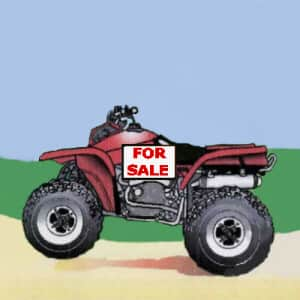Used ATV Buying Guide
ATVCamper 02.23.12

So you are looking to get an ATV for riding the trails, work around the house, and some ATV camping. If you are just starting out and not ready to spend the big bucks for a new one, there are several very nice used ATVs available for sale. There are also several very bad ATVs for sale so you need to know how to weed through all the listings and sales talk to find the used ATV that is right for you.
First you need to do some research on the brands and sizes available. There are seven major ATV manufacturers:
- Arctic Cat
- Can-Am
- Honda
- Kawasaki
- Polaris
- Suzuki
- Yamaha
Each of these manufacturers make some fine machines, but there were certain models and years from each manufacturer that had some issues. So talk to friends, other riders and visit some of the online ATV forums to get some information. Whichever brand you decide on, make sure you can get parts and have it serviced locally.
There are also several off-brand “low-priced” imports available and some of these ATVs may be good to start out on. Keep in mind that with most of these you get what you paid for and parts may be difficult to find.
For pricing check Kelly Blue Book (KBB) and the NADA, both list ATV and four wheeler prices under the motorcycle section. Mileage, condition and specifications need to be considered to get an accurate value of an ATV.
So you have narrowed down a couple of brands and sizes and and have a dollar figure you are willing to spend. Some good places to search are classified ads in your local newspaper, Craigslist, and eBay. With the current economy several ATVs have been repossessed and these ATVs are auctioned off at repossession ATV auctions around the country at unbelievable prices.
Before buying a used ATV you want to look it over and test drive it. Never buy an ATV “sight unseen” without an iron-clad guarantee. A couple of things to look at when inspecting a used ATV:
- Mileage and Hours – Gives an idea how much the ATV was used
- Plastic – Cracked and broken plastic indicates a possible wreck
- Frame – Look for bent and/or cracked frame members
- Suspension – Closely inspect the front a-arms for damage, check for loose hardware
- Axles – On independent suspensions check axle boots for cracks or tears, on straight axles check for straightness
- Oil – Pull oil dipstick to check condition of oil, milky oil indicates water in the crankcase. Smell for burnt oil
- Handlebars – Check for straightness. Bent handlebars indicates the ATV has been rolled in an accident
- Steering – Move handlebars from side to side. Inspect the steering linkage for worn and loose parts
- Motor Mounts – Ensure they are intact and secure
- Air Filter – Remove and inspect intake for debris. A dirty intake will indicate possible cylinder damage
- Tires – If they are worn, factor in the price for new tires
Start the engine to ensure easy starting and that it runs smoothly. Drive the ATV slowly and listen for abnormal noises. Watch the wheels for excessive wobble, indicating a bent rim or axle. Work the suspension by rocking the ATV from side to side. Accelerate the ATV then apply the brakes to ensure it stops in a straight line and that the brakes are good.
Ask the seller about the history of the ATV, especially if it was used for mudding. Mudding puts excessive wear and tear on the entire ATV. Take note of any accessories included with the ATV: winch, bags, helmet, etc. Don’t be afraid to negotiate a better deal and walk away if you are not satisfied with the deal.

